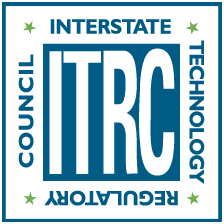Glossary
A
amendment (combination of reagents), or: The term amendment can refer to chemical compounds, natural or chemical additives, and/or commercially branded remediation products used for the purpose of achieving remediation goals and objectives.
B
Background demand of oxidant – is defined as reduced minerals (i.e. ferrous iron, manganous manganese), naturally occurring organic material, and/or other non-targeted, but organic contaminants that are present in the subsurface and will readily react with the added oxidant thereby consuming it.
E
emplacement – modify the subsurface permeability by pressurized application of a slurry.
I
injectate (that which has or will be emplaced including non-active ingredients/reagents such as carrier water and tracer)
injection – deliver a soluble amendment through pore space
P
Performance Indicator – A performance indicator is a measurable or calculable feature of a remedial system or process that provides direct interpretive value to (1) remedial mechanisms or processes or (2) achievement of a remedial objective. A performance indicator should be defined in terms of the technology being used, targeted media, receptor location, and expected response of the subsurface to treatment by the technology. Typically and historically, a performance indicator is the contaminant concentration; however, other performance indicators may provide information regarding the mechanisms responsible for decreases in contaminant concentration (e.g., percent of groundwater plume capture to demonstrate plume containment, mass flux to demonstrate source control, NAPL depletion rate, biodegradation rate).
Performance Metric – A metric is a unit of measure; therefore, a performance metric is the unit of measure for a performance indicator.
Performance Model – A performance model is a predictive model that describes the expected course of the remediation process. It describes graphically and/or numerically how conditions are expected to change over time, as measured using appropriate performance indicators, from the current state until the performance objective is achieved. At many sites and for many remedial systems, no single performance model, indicator, and metric is likely to be adequate for assessing remedial performance; thus, conjunctive use of multiple metrics may be needed to evaluate performance.
R
Reagent (individual active ingredient)
Remedial System Performance Objective – Performance objectives include specific measures used to determine whether or not the remedial action is successful in achieving site-related remedial goals or interim remedial milestones. Remedial performance objectives typically are site and technology specific, and based on the site-related remedial goals. They also vary depending on the type of contaminant being remediated (e.g., chlorinated volatile organics, petroleum hydrocarbons, metals, PCBs). When developing remedial system performance objectives, the practitioner should consider how the data will be used to evaluate progress, guide optimization, and demonstrate achievement of site remedial goals.
S
A secondary water quality impact is a change in the water chemistry caused by the added amendment which was not intended or designed for which creates a potential (and likely temporary) deterioration in water quality with respect to human and ecology health considerations or the objectives of the remedial treatment regime.
T
Target demand – The amount of amendment required to destroy the target contaminant.
W
Whip Checks act to control whipping in the event of a failure. Spring-loaded loops in the cable ends open easily to pass over the couplings, for a firm grip on the hose.
Click here to download the entire document.



